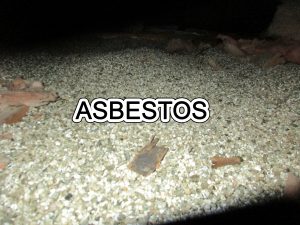Buyer Beware – Why You Need a Home Inspection

Potable Water – Recently this past summer I was inspecting a home where the dug well was being inspected by a licensed well inspector. Both Realtors had already performed their own well test and the water had passed the requirements for potability. the well inspector asked me to look at the well after he had removed the cover and there was feces floating on top of water. The home had a UV light filter and a cartridge filter installed which removed enough contaminants to allow water to pass. The clients walked away from this particular home.
WETT Inspections – Many times individuals call to have a wood stove that they have been using inspected due to a request from their insurance company. Wood stoves have to meet the required distances to combustible material as listed on a plate usually located on back of the stove. Many older stoves were not Certified which then requires a minimum distance of 48 inches from front, back and sides to combustible material. When buying a home always request a WETT Inspection to ensure you can continue to use appliance safely.
Asbestos – Many older homes had boilers and/or furnaces that was insulated with asbestos. Over the years the boilers were removed and most of the visible asbestos was also removed. Unfortunately many ducts which travel between floors or under floor boards still were wrapped with asbestos. Your trained home inspector will usually detect this asbestos and often the seller will remove the asbestos at their expense. If you fail to detect the asbestos then you will be responsible for the expense of removal.
Knob & Tube Wiring – Homes built prior to the 1950’s usually had knob and tube wiring installed. Many insurance companies will not insure a home with any knob and tube wiring installed. Many times during a home inspection I have found knob and tube circuits still in use and some which have even been used to extend an existing circuit during a home renovation. Some home owners and some electricians will skip removing all the knob an tube wiring because it is hard to access or they just think no one will ever notice or detect the remaining circuits.
Galvanized Plumbing – Galvanized plumbing was used in built in the early 1960’s and earlier and was quite common. Many insurance companies will not insure a home which has pressurized galvanized plumbing lines. Galvanized plumbing can contain lead which has collected from old lead supply lines and is known for corrosion which can reduce water flow, especially in the hot water line. Galvanized pipes are also known for corroding at joints and should be regularly inspected for potential leaks.
Vermiculite Insulation – Vermiculite is a naturally occurring product which is treated with heat to create insulation. One particular mine in Libby, Montana produced a lot of this particular product which was later found to contain asbestos. The only way to determine whether asbestos is present is to have samples collected and then sent to lab for testing. Removing and replacing asbestos for a small bungalow can start at around $15,000.00 and up. Many people have just installed newer type insulation over existing vermiculite in an effort to make detection difficult.
Aluminum Wiring – Check with your insurance company prior to buying a home with aluminum wiring. According to the US insurance company statistics having aluminum wiring in your home can increase the risk of fire by 55%. Everyone has a different point of view on the issues of aluminum wiring and as a consumer it is advised you educate yourself on the implications of buying a home with aluminum wiring installed.
Foundations – Earlier this year I received a phone call from an individual who had bought a recently renovated property. After the purchase was complete, without a home inspection, his neighbours informed him that there was no foundation for home. The seller had constructed a fake foundation cover while the home was actually built on wood logs sitting on the ground.
Building Permits – Many Do-It-Yourself contractors think nothing of totally renovating a basement without obtaining a building permit. If you buy such a home you are assuming responsibility for everything in the home. I have inspected homes under 10 years old that have improper electrical wiring and plumbing that is visible in renovated basement. If the home was ever inspected by electrical, plumbing or building inspector the walls and floors would probably have to be removed and all work redone. There is no insurance for this type of problem and as the home owner you would be totally liable for all costs.
Flooding – After buying a home a client of mine discovered mould on walls and flooring when she moved in to home. She called me back to assist her in determining what had happened to cause this problem. After thoroughly investing the basement I went to the exterior to find a probable cause and found nothing. I then checked with neighbours to see if they had encountered a similar problem. Bingo, the one neighbour informed me that her daughter had to go over to house to mop up a flood caused by a sump pump failure which the seller would not acknowledge or disclose. This eventually ended up in small claims court where settlement was reached in favour of my client.
Caveat Emptor – Buyer Beware Ultimately when buying a home the responsibility is solely that of the buyer. That is why it is so important for potential home buyers to educate themselves prior to deciding what home to buy.
Most people have a home inspection prior to purchasing a new home and home sellers know this. A home inspection cannot protect you from sellers who knowingly hide or fail to disclose material defects in a home. For example, say the subject property has a water issue in the basement every spring. The home sellers paint the walls with a fresh coat of paint and sell their home in the fall when there is no water issue. There is no moisture or water present to be detected by the home inspector and everyone is satisfied that the home is safe and sound by all appearances. The next spring you find water staining on your basements drywall and you want to find out why you were not told about this prior to purchasing home? You call your Realtor who will refer you to your home inspector, but what can he do? There was no water or moisture at time of inspection! If you talk to your neighbours and they inform you that this was an ongoing problem you could go after the sellers and recoup costs for repairs but that can be expensive and very stressful.
If you require a WETT Inspection of your fireplace or wood stove in the Barrie or Simcoe County area call Roger Frost at 705-795-8255 or Email Roger


